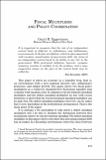| dc.contributor.author | Eggertsson, Gauti B. | |
| dc.date.accessioned | 2019-11-01T00:05:51Z | |
| dc.date.available | 2019-11-01T00:05:51Z | |
| dc.date.issued | 2013 | |
| dc.identifier.isbn | 978-956-7421-37-4 | |
| dc.identifier.uri | https://hdl.handle.net/20.500.12580/3892 | |
| dc.description | This paper is about an economy in a liquidity trap that is an environment with a zero nominal interest rate deflationary pressures and subpar growth. The paper shows two fiscal policy multipliers in a relatively standard New Keynesian liquidity trap economy with taxation costs. It computes real government spending multiplier and the deficit spending multiplier. In line with recent literature it shows that the real government spending multiplier can be quite big. The deficit spending multiplier however can be either big or zero depending on the institutional arrangement. That is the main point of the paper. | |
| dc.format | .pdf | |
| dc.format.extent | Sección o Parte de un Documento | |
| dc.format.medium | p. 175-234 | |
| dc.language.iso | eng | |
| dc.publisher | Banco Central de Chile | |
| dc.relation.ispartof | Series on Central Banking Analysis and Economic Policies no. 17 | |
| dc.rights | Attribution-NonCommercial-NoDerivs 3.0 Chile | * |
| dc.rights.uri | http://creativecommons.org/licenses/by-nc-nd/3.0/cl/ | * |
| dc.subject | POLÍTICA FISCAL | es_ES |
| dc.subject | LIQUIDEZ (ECONOMÍA) | es_ES |
| dc.subject | TASAS DE INTERÉS | es_ES |
| dc.subject | ECONOMÍA KEYNESIANA | es_ES |
| dc.title | Fiscal multipliers and policy coordination | |
| dc.type.doc | Artículo | |
| dc.file.name | BCCh-sbc-v17-p175_234 | |


